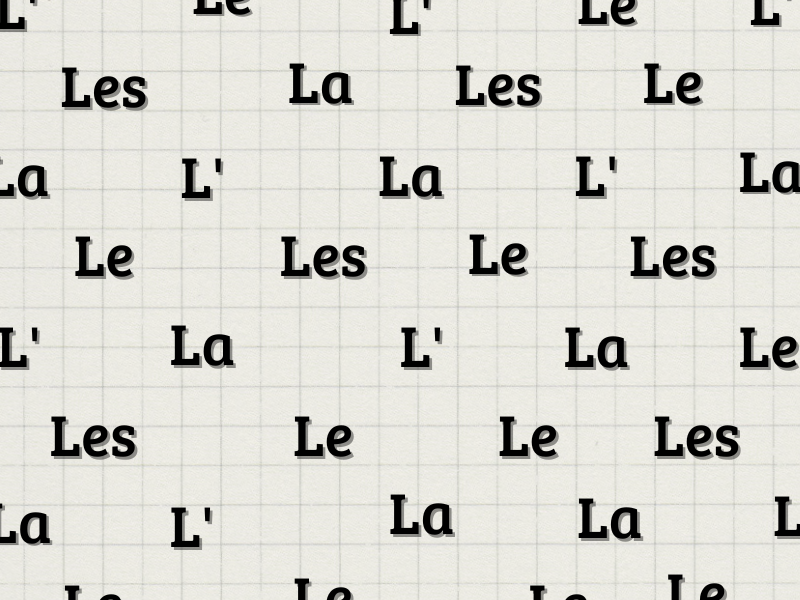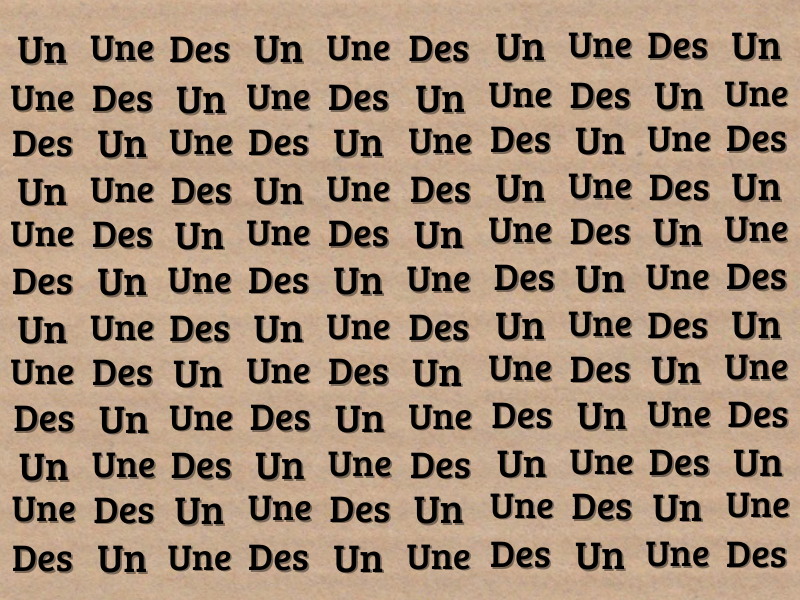Module 01: Bonjour!
Troisième Partie: La salle de classe / Explication de grammaire
In this section:
- Introduction aux noms / Introduction to Nouns
- Les articles indéfinis / Determiners: Definite Articles
- Les articles indéfinis / Determiners: Indefinite Articles
- “Voilà” vs “il y a” / “There is” and “There are”
Introduction aux noms / Introduction to Nouns

A noun is essentially a label for places, things, events, ideas, concepts and so on. Like English, nouns in French may be categorized as common or proper, count or mass, singular or plural. However, unlike English, French nouns are also categorized as either masculine or feminine.
common vs. proper
Common nouns in English and French are the generic term for something. Common nouns are never spelled with a capital letter unless they begin a sentence.
un serpent a snake
Proper nouns are specific names and thus begin with capital letters.
Sam et Sacha Sam and Sacha
count vs. mass
Another way of classifying nouns is according to whether they can be counted or not. Count nouns identify individual entities that can be counted, like chairs.
un chaise, deux chaises one chair, two chairs
In contrast, a mass noun refers to an entity as an uncountable unit. In the following example, the bread that Sam is eating is conceived of as a mass, that is, an undefined quantity.
Sam mange du pain. Sam is eating bread.
The difference between count and mass nouns is usually clearcut. However, something that is typically countable such as an animal (one snake, two snakes, three snakes) can nevertheless be conceived of in terms of a mass, as in the following tasteless example.![]()
| Berk! Il y a du serpent écrasé partout sur les autoroutes du Boise. | Yuck! There’s squashed snakes all over the Boise highways. |
singular vs. plural
All nouns in French and English are marked for number, that is, for singular (one) or plural (more than one). French, like English, usually indicates plurality by adding an -s to the end of the base form, the singular noun. Count nouns have both singular and plural forms:
le chien, les chiens the dog, the dogs
Mass nouns typically have only a singular form. Try saying the plural forms of the following English mass nouns: sewage, mucus, plasma.
It sounds strange doesn’t it? This shows that it is difficult to pluralize a mass noun.
masculine vs. feminine
In English, grammatical gender is based on biology and is only relevant for pronouns (he, she, it) and possessive determiners (his, her, its). Gender in French, on the other hand, affects all nouns, pronouns, adjectives and articles. A noun’s gender is indicated by the article that precedes it. Masculine nouns are preceded by le and feminine nouns by la. The use of articles in French is more widespread than in English.
![]()
| le garçon | the boy | |
| la fille | the girl |
![]()
Unlike English, the grammatical concept of gender in French has little to do with biological sex. Therefore, inanimate objects such as tables and desks are categorized as either masculine or feminine (there is no neuter gender in French grammar).
![]()
| la table (feminine) | the table | |
| le bureau (masculine) | the desk |
Remember that gender in French, for the most part, is not about sex, but is simply an arbitrary category. The terms ‘masculine’ and ‘feminine’ really mean nothing more than ‘noun class A’ and ‘noun class B’. Because grammatical gender is fairly arbitrary, it is essential to memorize a noun’s gender along with its spelling and pronunciation.
Les articles définis/ Determiners: Definite Articles

forms
In French, few nouns can stand alone. Most need to be introduced or ‘determined’ by an article. As in English, an article is characterized as either definite (‘the’) or indefinite (‘a’, ‘an’). In addition, French articles are also masculine or feminine, singular or plural, according to the gender and number of the noun they determine. Here are the definite articles in French:
| Masculine singular: le (l’) | le tableau le crayon |
the board the pencil |
||
| Feminine singular: la (l’) | la chatte l’Université de Boise |
the cat (female) The University of Boise |
||
| Masculine and feminine plural: les | les crayons les écureuils les chaises les universités |
the pencils the squirrels the chairs the universities |
élision and liaison
In the examples above, note that le and la both become l’ when they precede a noun beginning with a vowel or a silent h: l’escargot, l’université. This is called elision.
![]()
Unlike le and la, les does not have a contracted, reduced form. When les is followed by a word starting with a vowel, the normally silent final s of les is pronounced, making a /z/ sound. This additional sound linking two words is called liaison. Listen to the following examples:
| Compulsory liaison with a vowel or silent h | No liaison with a consonant |
| les enseignants les étudiants les hommes |
les professeurs les surveillants |
Note that elision and liaison occur with most words starting with h: l’homme, les hommes, l’hiver, les hivers. Exceptions to this rule are words beginning with an aspirate ‘h’.
to identify a specific noun
The definite article is used to identify a specific noun or to refer to a noun that has already been specified.
| Caleb: Tu connais la mascotte de l’université de Boise ? | Caleb: Do you know Boise State University’s mascot? | |
| Sam: Bien sûr, c’est le symbole de l’Université! | Sam: Of course, it is the symbol of the University! | |
| Caleb: Et l’allée Freak? | Caleb: What about Freak Alley? | |
| Sam: Eh bien, c’est l’une des destinations touristiques de Boise. | Sam: Well, it’s one of Boise’s tourist destinations. |
to express general truths or concepts
French uses the definite article to express general truths or concepts. English, in contrast, uses no article at all. Compare the following sentences:
| Sam: L’argent ne rend pas l’homme heureux! | Sam: Money does not make man happy! | |
| Caleb: Tu as raison. L‘amour et la santé sont plus importants! | Caleb: You are right. Love and health are more important! | |
| Sam: Bien sûr, pour les insectes et les animaux, l’argent n’existe pas! Mais l’amour est aussi important pour nous que pour les humains. | Sam: Of course, for insects and animals, money does not exist! But love is as important for us as it is for humans. |
to express likes and dislikes
The French also use the definite article with verbs of preference, such as aimer, préférer, détester. Once again, English omits the article in such general statements. For example:
| Sam adore les croissants. | Sam loves croissants. | |
| Caleb préfère les doughnuts. | Caleb prefers doughnuts. | |
| Sophie n’aime pas le café. | Sophie does not like coffee. | |
| Edouard apprécie la bonne cuisine française. | Edouard appreciates good French cuisine. |
to indicate habitual recurrence
The definite article is used in French with moments of the day, days of the week, and seasons to indicate habitual recurrence. For example:
| Le matin, Sophie va en cours. | Every morning, Sophie goes to class. | |
| L’après-midi, elle va à la bibliothèque. | Every afternoon, she goes to the library. | |
| Le lundi, Caleb fait son jogging. | On Mondays, Caleb goes for a jog. | |
| L’été, il se baigne avec Sacha à Redfish Lake. L’hiver, il skie à Bogus Basin. | Every summer, he bathes with Sacha at Redfish Lak. Every winter, he skis in Bogus Basin. |
in a series
The article is usually repeated in a series, in contrast to English. For example:
| Caleb: Sacha, aide-moi à mettre la table! Apporte les assiettes, les couteaux, les verres, les serviettes et le vin. | Caleb: Sacha, help me set the table! Bring the plates, knives, glasses, napkins, and wine. |
no article
Cities usually do not require an article in French. For example:
| Alex habite à Boise, mais iel préfère Montréal. | Alex lives in Boise, but they prefer Montreal. | |
Continents, countries, states, regions, and oceans usually require an article (l’Afrique, la France, le Texas, la Bourgogne, l’Atlantique etc.), but there are a few exceptions, usually islands: Haïti, Israël, Madagascar. See prepositions with place names for more information.
Months never require an article: janvier, février, mars, etc.
| Cependant Sam adore mars à Austin. | Nevertheless Sam adores March in Austin. |
Days of the week do not require an article in instances where they do not indicate habitual recurrence. For example:
| Lundi, il a rendez-vous avec Sophie. | Monday he has a date with Sophie. |
Listen to the dialogue:
| Sophie: J’aime beaucoup le français. C’est la langue de Molière et de Hugo, et surtout c’est la langue maternelle de Edouard! | Sophie: I like French a lot. It is the language of Molière and of Hugo, and above all it is the mother tongue of Edouard! | |
| Sacha: Alors Sophie, tu aimes bien le littérature Français? | Sacha: So Sophie, you really like French literature? | |
| Sophie: Oh oui! Surtout les livres qui se déroulent en Paris! | Sophie: I sure do! Especially books that take place in Paris! |
Les articles indéfinis / Determiners: Indefinite Articles

forms
In French, few nouns can stand alone. Most need to be introduced or ‘determined’ by an article. As in English, an article is characterized as either definite (‘the’) or indefinite (‘a’, ‘an’). In French, articles are also masculine or feminine, and singular or plural, according to the gender and number of the noun they determine. Here are the indefinite articles in French:
| masculine singular: un | Sam est un étudiant. Edouard est un serveur à temps partiel. |
Tex is a student. Edouard is a part-time server. |
||
| feminine singular: une | Sophie est une présidente de ASBSU. BSu est une université. |
Sophie is a president of ASBSU. BSU is a university. |
||
| plural: des | des professeurs des étudiants des présidents des universités |
(some) professors (some) students (some) presidents (some) universities |
In the examples above, listen carefully to the difference in pronunciation of un and des before words beginning with a consonant (un tatou, des tatous) and before a words beginning with a vowel sound (un écureuil, des écureuils). These are examples of liaison.
uses
As the English ‘a’ ‘an’ or ‘some’, the indefinite articles un, une, des refer to nouns which are non-specific. Un or une may also indicate quantity, ‘a’ or ‘an’ in the sense of ‘one.’ Contrast the use of the indefinite and definite articles in the first two sentences below. The indefinite plural des is always expressed in French, but its English equivalent ‘some’ is often omitted.
| Edouard et Caleb ont une chambre dans une résidence universitaire à Boise. | Edouard and Caleb have a dorm room in a residence hall in Boise. | |
| Ils ont la chambre numéro 1735 dans la résidence Honors college. | They have room #1735 in the Honors residence hall. | |
| Edouard et Caleb sont des camarades de chambre. | Edouard and Caleb are roommates! |
‘de’ after the negative
In a negative sentence, the indefinite articles un, une, des are replaced by de or d’:
| Sam: Edouard, tu as un chien? | Sam: Edouard, do you have a dog? | |
| Edouard: Mais non! Je n’ai pas de chien. Je suis trop jeune. | Edouard: No, I don’t have a dog. I’m too young. | |
| Sam: Caleb, tu as des amis? | Sam: Caleb, do you have friends? | |
| Caleb: Non! Je n’ai pas d‘amis. Je suis tout seul. | Caleb: No, I don’t have any friends. I’m all alone. |
However, following the verb être, the indefinite articles un, une, des remain unchanged in the negative:
| Eliot: Edouard est un professeur. Ce n’est pas un surveillant! | Eliot: Edouard is a professor. He is not a monitor! | |
| Sam et Sacha sont des adultes. Ce ne sont pas des collégiens. | Sam and Sacha are adults. They are not schoolkids. |
before a plural adjective
Before a plural adjective which precedes a noun, des usually becomes de. If the adjective comes after the noun, des does not change to de.
| Eliott: Sam et Sacha sont des élèves turbulents. | Eliott: Sam and Sacha are unruly students.. | |
| Sophie: Ah bon? Ce ne sont pas les plus intelligents? | Sophie: Really? Aren’t they the smartest? | |
| Eliott: Ils le sont! Mais ils ne font pas d’effort… | Eliott: They are! But they don’t make any effort… | |
| Sophie: Nous devrions les encourager! | Sophie: We should support them! |
with adjectives of profession, nationality, and religion
Professions, nationalities and religions are considered adjectives in French and need no article after the verbs être and devenir.
| Elliott: Alex veut devenir dentiste. Iel vient de Canada. Il n’est pas américain.e. | Elliot: Alex wants to become a dentist. They are from Canada. They are not American. |
Listen to the dialogue:
| Sophie et Sacha parlent franchement. | Sophie and Sacha are speaking in private. | |
| Sophie: Je n’ai pas de véritables amis! Tout le monde pense que je suis une personne hypocrite. | Sophie: I have no real friends! Everybody thinks that I am a hypocritical person. | |
| Sacha: Mais non Sophie! Toi et moi nous sommes de vieilles amies! | Sacha: That’s not true Sophie! You and I are old friends! | |
| Sophie: Oui, mais tu ne me parles jamais…Tu restes toujours avec tes nouvelles connaissances. | Sophie: Yes, but you never talk to me… You always spend time with your new friends. | |
| Sacha: Désolé Sophie, j’ai été très occupée ces dernières semaines. | Sacha: Sorry Sophie, I have been very busy these last few weeks. |
“Voilà” vs “il y a” / “There is” and “There are”

Il y a and voilà are two ways of introducing nouns. They are translated into English as ‘there is / there are’ or ‘here is / here are.’
![]()
il y a
Il y a + noun usually indicates the existence of a person or a thing in the context of a particular setting. It is commonly translated as ‘there is’ or ‘there are.’ For example:
| A Austin, il y a une grande université. | In Austin, there is a big university. | |
| Dans cette université, il y a plusieurs animaux qui parlent le français! | At this university, there are several animals who speak French! | |
| Parmi ces animaux, il y a des tatous, un escargot, une chatte, un écureuil, et plusieurs insectes! Attention! | Among these animals, there are armadillos, a snail, a cat, a squirrel, and several insects! Careful! |
The negation of ‘il y a’ is il n’y a pas, ‘there is / are not’. You will also find these forms: il n’y a plus, ‘there is / are not anymore’, il n’y a jamais, ‘there is / are never’.
| A Austin, il n’y a jamais de neige. | In Austin, there is never any snow. | |
| Donc parmi ces animaux francophones, il n‘y a pas de pingouin! | So, among these French-speaking animals, there is no penguin! |
The verb avoir in the expression il y a may be conjugated in any tense or mood, for example, in the past (il y avait, ‘there was’) or in the future (il y aura, ‘there will be.’)
voilà / voici
Voilà + noun and voici + noun are commonly translated as ‘here is/are’. They are used to indicate the sudden appearance of something or someone, to introduce people or ideas. Alternating between voici and voilà is common when referring to more than one item.
| Tammy montre le campus à Tex: Voici la bibliothèque et voilà la célèbre tour! | Tammy is showing the campus to Tex: Here is the library, and there is the famous Tower. | |
| Tex: Oui, oui … | Tex: Yes, yes … | |
| Tammy présente Tex: Tex, voici Joe-Bob et Corey … et voilà Edouard qui arrive. | Tammy introduces Tex: Tex, here is Joe-Bob and Corey … and there comes Edouard. | |
| Joe-Bob: Bonjour, Tex. | Joe-Bob: Hello, Tex. | |
| Corey: Salut, Tex. | Corey: Hi, Tex. | |
| Tex: Oh, la, la, de vrais Texans … | Tex: Oh, la, la, real Texans … |


